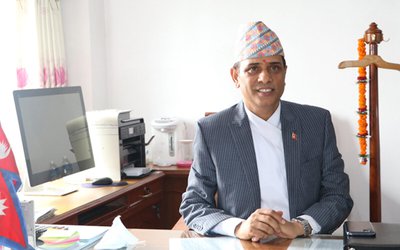Within a second, a flash flood from Seti river washed out villages and tiny markets in the remote parts of Kaski district near the Annapurna range. It also turned many parts of Kaski flat killing at least 50 people and destroying the property worth millions of rupees.
Snow melting poses a major hazard in Nepal’s mountains . And Glacier Lake Outburst has been creating havoc in various parts. Although it is yet to be scientifically verified and justified, the flash floods in Seti river were the result of snow slides in the Machhapuchre mountains.
The temperature rise has already posing serious threats to Nepal’s glaciers. According to Water and Energy Commission, out of over 3100 glaciers in Nepal, more than 30 glaciers are in highly dangerous positions and they can be outflanked any time.
Imdza glaciers of Khumbu region and Tsho Rolpa are in a very dangerous situation. Although Nepal government has installed early warning system along river side from the Tsho Rolpa lake, it is now virtually defunct due to poor maintenance.
If Imdza and Tsho Rolpa see outbursts, Nepal’s eastern region would have to face huge losses running down to the Kosi riversides in the plains. The flash flood of a relatively invulnerable area should serve as an eye opener. “It is too early to say that the recent floods in Pokhara were caused by GLOF,” said Madhav Mul, an expert with ICIMOD. “Nevertheless, Nepal’s Himalayas are under threat of rising temperatures.”
Nepali researchers have sounded another alarm bell. Glacial lakes in the Hindu-Kush-Himalayas could pose a major hazard to population centers if they are ruptured by earthquakes, the scientists warn. Experts believe that, based on past records, a large quake in the region is overdue. When the last earthquake hit the region, there were barely any glacial lakes in the Himalayas. A recent report on Nepal's glaciers said their average area had increased by 33 per cent.
Outburst of glacial lakes has been put off because big earthquakes have not hit the region in recent decades.
A recent report produced by the World Bank and the Global Facility for Disaster Reduction and Recovery has also said, that such a hazard "is a possibility that should be considered, although prediction [of earthquakes] is beyond current competence."
Officials with Nepal's National Seismological Centre (NSC) say at least half a dozen minor tremors are recorded in the Himalayas every day. "And when the tremor is [Magnitude] five or above... we record many aftershocks as well," says Dilliram Tiwari of the NSC. "We know that these activities are happening in the Himalayas but we cannot confirm if they are happening near any glacial lake. That is because hardly any seismic meters are installed near the lakes.
Recent floods in Pokhara are just a beginning and the country will have to go a long way before achieving a risk-free future.
- TANAHU HYDROPOWER PROEJCT: A Significant Achievement
- Apr 15, 2024
- AMBASSADOR HANAN GODAR: Sharing Pain With A Nepali Family
- Mar 30, 2024
- VISIT OF KfW AND EIB TO NEPAL : Mission Matters
- Mar 25, 2024
- NEPAL BRITAIN SOCIETY: Pratima Pande's Leadership
- Mar 24, 2024
- NEPAL ARMY DAY: Time To Recall Glory
- Mar 15, 2024
















